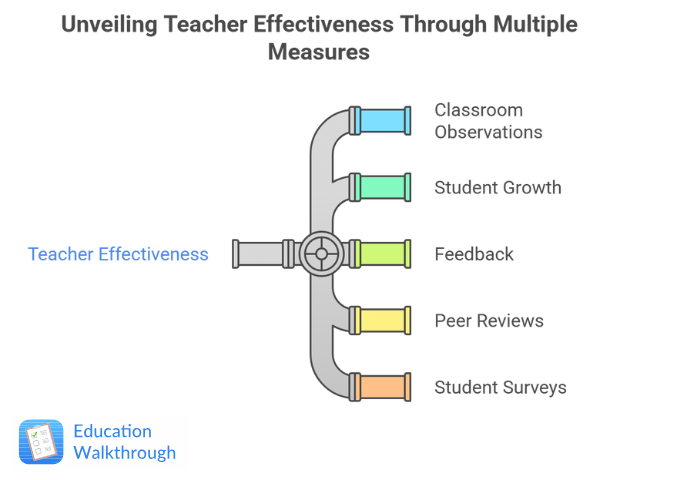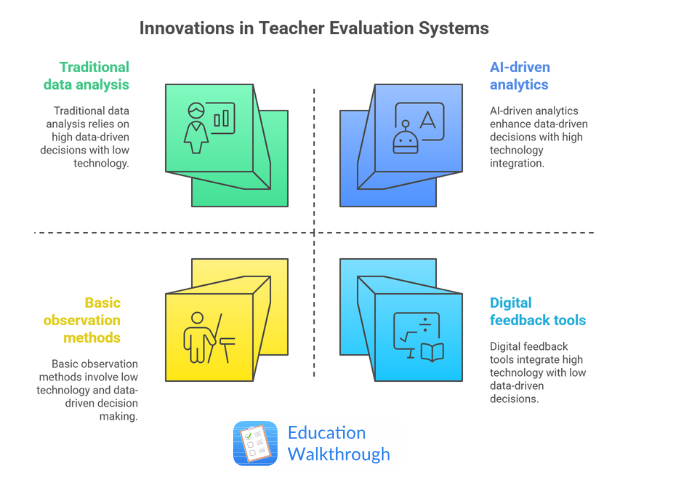Great teaching is the cornerstone of every successful classroom, shaping the future one student at a time. A learning environment buzzing with curiosity and growth depends on teachers who continually sharpen their skills to inspire and engage. Teacher evaluations serve as a vital tool in realizing this goal, offering structured, meaningful feedback to enhance classroom performance.
This guide unpacks what teacher evaluation is, how it’s conducted, and why it’s vital in education. From core components to innovative approaches, you’ll find practical strategies to improve teaching quality and student success. Ready to transform education? Let’s begin the journey.
Key Takeaways
- Effective teacher evaluation systems are essential for promoting continuous professional growth and enhancing student outcomes by providing comprehensive assessments including observations, student feedback, and performance data.
- Different evaluation models such as RISE and LEAP, utilize a variety of metrics to assess teaching effectiveness, ensuring a holistic understanding of performance metrics for educators beyond standardized test scores.
- Addressing biases and ensuring fairness in evaluations, along with integrating technology and data-driven evaluation approaches, are crucial for building trust and enhancing the overall effectiveness of teacher evaluation processes.
Understanding Teacher Evaluation Systems

See the classroom as a vibrant hub, with the teacher skillfully guiding students toward growth. A teacher evaluation system is designed to assess the effectiveness of teachers and promote better learning experiences for students. In a 2023 National Center for Education Statistics (NCES), the report highlighted ongoing challenges in teacher retention and emphasizes the role of supportive evaluation systems in promoting professional growth and engagement.
These systems provide an opportunity for educators to reflect seriously on their practice, supporting continuous professional growth and improvement in teaching practices. As a result, effective teacher evaluations can significantly improve instruction, leading to better student outcomes.
Moreover, evaluations are not just about identifying areas for improvement; they also recognize excellence and provide meaningful feedback that can motivate and inspire teachers. In addition, they offer a holistic view of a teacher’s performance by combining measures of student learning and teacher practice. This comprehensive approach ensures that all aspects of teaching, from lesson planning to classroom management, are taken into account.
Moving forward, the ultimate goal of teacher evaluation systems is to ensure high-quality instruction that benefits both teachers and students. These systems help create a more effective and motivated teacher workforce by supporting a culture of continuous improvement. With this foundation, let’s explore the key components and models driving these systems.
Key Components of Teacher Evaluation Systems
An effective teacher evaluation system involves multiple assessments conducted frequently by both teachers and administrators. These assessments typically include structured classroom observations, measures of student achievement growth, and student perceptions.
For example, survey questions like “Does your teacher explain concepts clearly?” or “How supported do you feel in class?” capture student insights. The combination of these elements provides a well-rounded view of a teacher’s effectiveness and their impact on student learning.
Also, to ensure accuracy and comprehensiveness, evaluations should include both formal and informal observations. Formal observations are planned and structured, while informal observations can happen spontaneously, offering a more genuine glimpse into everyday teaching practices.
Evaluators assess not only the teacher’s actions but also student learning and interactions during these observations. A prime example of this holistic approach is the Teacher Development and Evaluation System, using multiple measures to assess teacher performance. This adaptability and emphasis on comprehensive educational assessment methods are important for improving teaching quality evaluation and supporting professional growth.
Types of Teacher Evaluation Models

Different teacher evaluation models utilize various metrics to assess teaching effectiveness. The Recognizing Instructional Success and Excellence (RISE) model, for instance, is growth-oriented and involves multiple observations and teacher self-reflection practices.
This model encourages teachers to reflect on their practices and set personal goals for improvement, supporting a culture of continuous development. To illustrate, a teacher might aim to incorporate more collaborative projects after reviewing student engagement data.
On the other hand, the Leading Effective Academic Practice (LEAP) model, developed by Denver public school teachers, incorporates observations, professionalism, student perception surveys, and student growth. Utilizing diverse metrics, these models provide a more comprehensive evaluation of a teacher’s performance.
Each model has its unique strengths, and schools can recommend model evaluation systems that best suit their needs. With this in place, schools adopting LEAP often see improved classroom environment due to its focus on student feedback, such as surveys asking, “How often do you participate in class discussions?”
Importance of Teacher Evaluations in Education
Teacher evaluations are pivotal in the education system as they directly impact teaching quality and student learning outcomes. These evaluations provide a structured framework for ongoing professional development for teachers, addressing the evolving needs of educators. Furthermore, teacher evaluations ensure that high-quality instruction is consistently delivered in classrooms by focusing on continuous improvement.
The process of evaluating teachers serves as an opportunity for genuine professional learning programs. Educators can develop their instructional performance review skills, receive constructive teacher feedback, and set formative goals that skyrockets their teaching practices. This structured approach to professional development benefits both teachers and students, creating a positive and effective learning environment.
Overall, effective teacher evaluations play an important role in ensuring that educators can meet the diverse needs of their students. That way, these evaluations can contribute significantly to the success of the education system and help to evaluate teachers.
Steps to Conducting Effective Teacher Evaluations
Are evaluations capturing the true essence of teaching or merely scratching the surface? Conducting teacher evaluations requires meticulous planning and documentation to ensure all aspects are considered, says Dr. Linda Darling-Hammond: “Evaluations must reflect practice accurately” (Stanford). Key factors in the evaluation process include classroom handling, student outputs, assessments, lesson plans, and daily records. Active participation from students and faculty also plays a significant role in shaping the evaluation process.
The evaluation process typically involves three main steps: preparing for the evaluation, conducting observations, and providing constructive feedback. Each step is important in ensuring that evaluations are fair and comprehensive in promoting teacher growth. Let’s break down these steps to understand their importance.
Step 1: Preparing for the Evaluation

Preparation for teacher evaluations involves clear communication of expectations and criteria to all involved parties. Providing structured rubrics and standardized evaluation criteria can help minimize personal biases and ensure that evaluations focus on specific teaching methods and learner outcomes. Illustratively, a rubric might emphasize “Uses varied questioning techniques to engage all students.” Clear criteria helps set the stage for a fair and unbiased evaluation process.
The use of structured rubrics and objective criteria reduces bias because it also ensures that all teachers are assessed based on the same standards, thereby promoting consistency and fairness in teacher assessments, making it more reliable and effective.
Step 2: Conducting Observations

In conducting observations, school leaders must prioritize frequent classroom observations to accurately assess teaching effectiveness, and this can be done in two ways. Effective teacher evaluations include both formal and informal observations; both of which are typically run alongside digital tools like Socrative that contribute to capturing a holistic view of teaching practices. Although formal observations are planned and structured, informal observations can occur spontaneously, providing a more genuine glimpse into everyday teaching practices.
The use of mobile applications during classroom observations allows for real-time feedback, improving the responsiveness of the evaluation process. These digital tools streamline the process, making it more efficient and effective in capturing the dynamic elements of teaching practices.
Step 3: Providing Constructive Feedback

Providing constructive and specific feedback after observations is essential for promoting teacher improvement. Feedback should focus on specific areas for improvement, encouraging professional growth evaluation rather than just evaluation scores. Exemplifying this would be specifically suggesting that “Incorporating think-pair-share would increase student participation” as opposed to “student participation is quite low”. The corner offers actionable guidance whilst the latter is basically just restating an obvious problem. Effective feedback mechanisms enable teachers to understand their strengths and areas where they would need to improve.
To further encourage transparency and honesty in feedback, incorporating anonymous feedback mechanisms can help reduce bias by limiting preconceived notions about instructors’ identities. Digital platforms like MyTIP are enabling real-time feedback during evaluations, which improves the immediacy and relevance of the assessment process for teachers.
Common Challenges in Teacher Evaluation Systems
In my early days as a principal, I faced a daunting challenge: evaluations usually bred tension, not growth. Teachers felt judged, and I struggled to keep feedback fair. Bias clouded judgments, and trust continued to dwindle, it was basically a classic tale of good intentions gone awry. But by introducing clear rubrics and open dialogues, we were able to rebuild confidence, and completely turned evaluations into a shared mission that everyone looked forward to.
Implementing teacher evaluation systems comes with its own set of challenges, some of which I already mentioned earlier including bias and lack of trust, and if not handled professionally, can significantly affect the fairness of teacher evaluations, leading to inconsistent results. This is why maintaining consistency and fairness in the evaluation processes can not be overemphasized because that’s how to ensure that all teachers are assessed equally.
Addressing Bias and Subjectivity
Achieving this consistency depends on the use of standardized rubrics combined with thorough training for evaluators, which together, helps minimize bias. When evaluators are well-trained, the reliability of assessments improves significantly, making sure that evaluations are applied uniformly across all teachers.
I mean, workshops focused on objective observation techniques can help align evaluators’ perspectives, inspiring a shared understanding of evaluation criteria. In fact, beyond initial training, regular monitoring of evaluation practices is just as important in identifying and addressing any discrepancies that may arise during comprehensive teacher assessments.
That being said, minimizing bias within the evaluation system is essential not only for fairness but also for maintaining the integrity of the process.
Implementing standardized rubrics, targeted training, and ongoing monitoring creates a fair and objective evaluation system that genuinely supports teacher growth. This foundation sets the stage for the crucial next step: building trust between teachers and evaluators to advance collaboration and continuous improvement.
Building Trust Between Teachers and Evaluators
Creating trust between teachers and evaluators is a bit like planting a garden. You can’t just toss in the seeds and hope for the best; it takes attention and plenty of open communication. School leaders play the role of gardeners, nurturing a culture of trust and collaboration that helps the teacher evaluation process seamless. Celebrating teachers’ successes during evaluations is like watering those plants, it encourages growth and strengthens the bond between educators and evaluators.
Trust isn’t just a nice-to-have; it’s one of the core strategies that makes the evaluation process feel supportive rather than stressful. When trust is in place, teachers feel valued and motivated, paving the way for a more positive and effective evaluation environment.
Measuring Teacher Effectiveness Beyond Test Scores

The question is: “what keeps great teachers in the classroom?” Well, research shows that when schools use multiple measures to evaluate teachers-such as classroom observations, student growth, and feedback-educators feel more supported and valued. This comprehensive approach incorporates both subjective and objective measures to assess performance.
That way, teachers grow professionally and schools record higher retention rates, ensuring that students benefit from experienced, committed educators year after year; a typical win-win situation.
Not only that, considering a variety of factors beyond standardized test scores helps schools achieve a more accurate and holistic evaluation of teacher effectiveness. This approach ensures that all aspects of teaching are taken into account, leading to a more comprehensive assessment.
Sidebar: Beyond the Test
- Peer Reviews: Where colleagues highlight instructional strengths.
- Student Surveys: Questions like “How engaged are you in lessons?” measure classroom climate.
- Observations: Walkthroughs reveal daily teaching dynamics.
Utilizing Multiple Measures
Incorporating multiple evaluation methods can help reduce bias in teacher assessments. This includes combining different evaluation measures which can lead to more accurate assessments. But the process is not without its own hurdles as it requires careful consideration of accuracy and implementation challenges.
Despite this, utilizing a variety of evaluation methods helps schools achieve a more comprehensive view of a teacher’s performance. This approach ensures that all aspects of teaching are taken into account, leading to a more accurate and holistic evaluation.
Incorporating Student Feedback
Evaluators should encourage teachers to perform student surveys to identify curriculum struggles and gain insights into teaching practices and classroom environments. Incorporating student surveys into teacher evaluations improves the feedback loop between students and educators. These surveys provide valuable insights that standardized tests cannot capture, such as student engagement and perceptions of the learning environment.
Therefore, making the most of feedback from students can lead to improvements in teaching strategies and boost student learning outcomes. Lastly, considering student feedback mechanisms allows teachers to make informed adjustments to their instructional methods, ultimately benefiting the overall learning experience.
The Role of School Leaders in Teacher Evaluations
School leaders guide evaluations like skilled gardeners, tending to growth with care. Leadership can be much better if it is focused on uplifting rather than directing. By prioritizing support over control, school leaders create an environment where teacher evaluations become a shared journey toward improvement rather than a one-sided judgment.
As a result, teachers often believe that classroom performance evaluations lead to clearer insights into their teaching abilities and areas for improvement. Building on this, teacher leaders involve themselves in improving teaching practices and conducting training during the teacher evaluation process. This involvement ensures that evaluations are not just about assessing performance but also about supporting teachers’ professional growth and development.
Supporting Teacher Growth
More than just assessments, teacher evaluations are tools perceived by teachers that aid in recognizing teaching excellence and guiding improvements.
A significant number of teachers report that teacher performance evaluations offer the chance to create personalized professional development plans. Fundamentally, professional development opportunities must be customized to address the specific areas highlighted through evaluations.
This targeted approach not only sharpens teaching skills but also builds trust in the evaluation process. When evaluators emphasize nurturing teacher growth rather than simply pointing out shortcomings, confidence in the system deepens, stimulating a more supportive and productive environment for continuous learning.
Ensuring Consistency and Fairness
To ensure fairness in evaluations, it is essential for school leaders to implement standardized criteria that apply to all educators. Fair evaluations depend on clear communication of expectations and criteria to all teachers involved. Maintaining fairness in evaluations is crucial to ensure objectivity and trust in the teacher evaluation process.
The combination of standardized criteria and clear communication promotes an equitable evaluation environment. When consistency and fairness is ensured, school leaders can build a more reliable and effective teacher evaluation system.
Innovations in Teacher Evaluation Systems

What if evaluations could be both swift and insightful? Emerging teacher evaluation systems increasingly incorporate innovative practices to improve efficiency and efficacy. For instance, AI-driven analytics and gamification, like earning badges for professional milestones, add a fresh twist, engaging teachers in new ways. Modern teacher evaluation systems are utilizing online and automated methods to reduce the time and resources required for assessments.
Moreso, leveraging technology and data analytics helps schools achieve more accurate assessments and improve feedback mechanisms. These advancements are fundamental for creating a more effective and supportive evaluation environment that benefits both teachers and students.
Integrating Technology in Evaluations
Digital platforms are transforming the evaluation process by automating feedback collection and improving communication. These tools enable seamless peer evaluations, encouraging collaboration among teachers and cultivating a supportive evaluation culture.
Education Walkthrough’s app is the game changer. It streamlines real-time feedback, making observations and assessments more efficient. In addition, integrating digital tools into evaluation rubrics and criteria not only boosts efficiency but also boosts the overall effectiveness of teacher assessments.
Also, the adoption of technology in teacher evaluations results in more accurate assessments and richer feedback mechanisms. Therefore, by leveraging these innovations, schools can develop dynamic, responsive evaluation systems that actively support continuous professional growth and improvement in teaching quality.
Data-Driven Decision Making
Effective data-driven decision making in evaluations depends on analyzing various data sources to guide instructional improvements. Leveraging data analytics promotes transparency and accountability in teacher performance assessments, enabling schools to make informed decisions that improves teaching and student outcomes. This research-based approach grounds evaluations in solid evidence, supporting continuous improvement.
Here’s the twist: data-driven evaluation is about combining quantitative data with qualitative insights to capture the full complexity of teaching.
In embracing this dynamic interplay between data and human insight, schools cultivate evaluation systems that are adaptive and deeply supportive of continuous professional development, turning data from a cold statistic into a catalyst for meaningful educational transformation.
Teacher Evaluation Wrapped
As we have seen, teacher evaluations are essential tools for improving teaching practices and student outcomes. By incorporating multiple measures, including observation frameworks, student feedback, and data analytics, schools can achieve a comprehensive and fair assessment of teacher performance.
These evaluations not only identify areas for improvement but also recognize and celebrate teaching excellence. Lastly, effective systems support a culture of continuous professional growth, ensuring educators meet various student needs.
Take the next step today! Learn how Education Walkthrough’s services can strengthen your evaluations.
Frequently Asked Questions
What is the purpose of teacher evaluations?
Teacher evaluations serve to assess teaching effectiveness, ensuring continuous improvement in instructional quality and enhancing students’ learning experiences.
What are the key components of an effective teacher evaluation system?
An effective teacher evaluation system should incorporate structured classroom observations, measures of student achievement data, and insights from student perceptions. This comprehensive approach ensures a well-rounded assessment of teaching effectiveness.
How do teacher evaluations impact student outcomes?
Teacher evaluations have a positive impact on student outcomes, as well structured evaluations lead to improved academic performance. This emphasizes the importance of effective assessment practices in enhancing student learning.
How can bias be minimized in teacher evaluations?
To minimize bias in teacher evaluations, implement standardized rubrics, provide training for evaluators, and employ multiple evaluation methods. These strategies ensure objectivity and fairness in the assessment process.
What role do school leaders play in teacher evaluations?
School leaders play an important role in teacher evaluations by ensuring consistency and fairness while supporting effective assessment practices that promote teachers’ professional growth.



